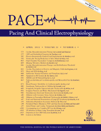Fetal and Neonatal Presentation of Long QT Syndrome
Abstract
This report describes a fetus presenting with intrauterine tachycardia and hydrops fetalis. Soon after birth the neonate was noted to be in torsades de pointes that responded dramatically to medical management. Long QT syndrome (LQTS) was diagnosed on electrocardiogram obtained soon after birth. The prognosis is poor when LQTS presents in utero or during the first week of life. However, our infant did well with medical management and has remained free of arrhythmias at follow-up. PACE 2012; 35:e87–e90)




